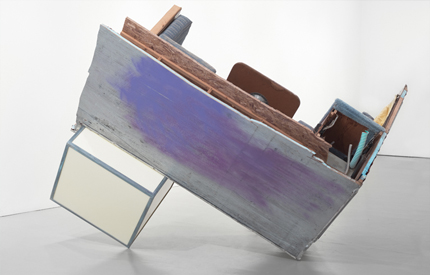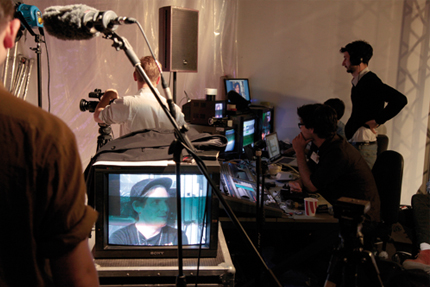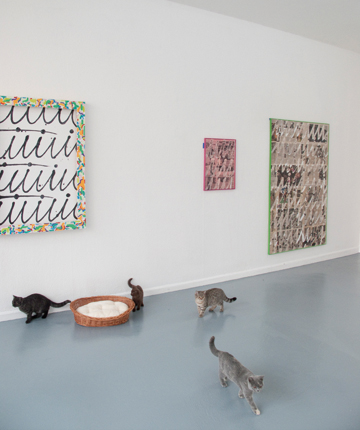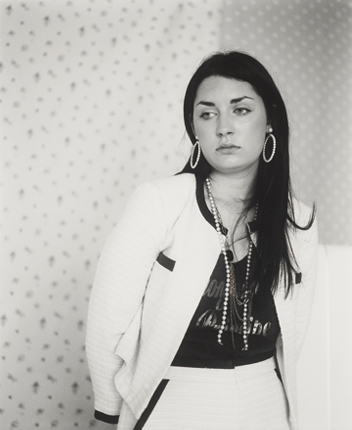Four Artists Of Importance
| February 4, 2012 | Post In LEAP 12

1. SARAH BRAMAN
At the age of 43, Sarah Braman has finally made her mark on the international contemporary art world. A long-time presence in the downtown Manhattan scene, Braman co-owns the well-respected Lower East Side gallery CANADA with her husband Phil Grauer, in addition to making sculpture. Supporting her two children, artistic practice, and the early stages of the gallery through the sort of back-breaking labor only desperate New Yorkers would understand, Braman could be seen as an underdog finally coming to full fruition when given the chance, or in her own words, a “Seabiscuit figure.” Within the last two years, Braman has presented solo exhibitions at the Armory Fair and Museum 52 in New York; MACRO in Rome, Italy; the Institute d’art Modern in Paris; and has participated in group shows in established institutions and galleries such as the Zabludowicz collection, the Lisbon Biennial, Johan König, Berlin; as well as Zach Feuer and Leo Koenig in New York.
Most recently, Braman launched a solo exhibition at the estimable Chelsea gallery Mitchell Innes and Nash. Titled “Yours,” the exhibition slices and deconstructs a recreational vehicle with the aggressiveness of Matta-Clark, its insides repackaged into modular constructions and painted upon with soft, purplish hues. Braman’s work, phenomenologically impressive, reads as feminine, yet resists a reductionist definition of the term. Embracing movement both in time and vantage, the artist allows nostalgia to seep into her work while also forcing the viewer to rotate around its gargantuan size, activating it physically and emotionally. Braman is represented by Mitchell-Innes & Nash, New York, and works closely with CANADA, New York, as well as Museum 52, London and New York.

2. LUCKY PDF
Forget about the terms “artist group” or “collective”: the four wiry London men comprising Lucky PDF could masquerade just as much a dodgy boy band as they could an ensemble of artists. Well— perhaps a supremely nerdy boy band. James Early, Ollie Hogan, John Hill, and Yuri Pattison, who were all born in 1986 but attended different South London art schools, in 2008 united to create an experimental exhibition space in Peckham, South London, and have since become an enigmatic collective creating and producing oft-confounding videos and new media works. Lucky PDF outsources the commissioning, funding, and creation of ambitious artworks by tapping their expansive list of highly capable peers. Instead of waiting to get a grant to create a video series, for example, Lucky PDF would throw a party in South London, charge an admission fee, and use the proceeds to rent equipment for a collaboration with their friends.
In recent years Lucky PDF has charmed its way through the London art scene, receiving commissions from the Barbican and, most recently, the Frieze Art Fair. Recruited by Frieze Foundation curator Sarah McCrory, the Lucky PDF boys created a series of five live TV episodes hosted by their peers and colleagues, ranging from SPACE London curator Paul Pieroni to well-known internet artist Rafaël Rozendaal. The format of each episode loosely adheres to a late night show or variety evening, mixing live music acts with more artistic performances, as well as more abstract video art and specially-created TV show idents that look straight out of the 1980s. Lucky PDF most recently traveled to Athens for “Free Galaxias,” a video project for “Word of Mouth” curated by KERNEL as part of the 3rd Athens Biennale.

3. NIKOLAS GAMBAROFF
If you were wondering whether it is possible to create sober work that considers the commodification of art and juxtapose this with an installation of kittens, look no further than Nikolas Gambaroff. The New York-based artist has gained attention for his paintings, wherein he flattens newspaper broadsheets, encrusts them with italic, wave-like strokes of gesso, and tears off their top portions. Creating an aesthetically psychedelic effect, Gambaroff’s newspaper paintings superimpose one broadsheet advertising new cars and personal ads with another announcing the political happenings of that day. Encasing them in colored, kitschy frames, Gambaroff designates these works to exist in the realm of high art— a meditation on the propensity of such to be variably looked at as a luxury good to be sold or traded, a pursuit tied to one’s identity and lifestyle, a form of communication, a political position, and so on. For his recent exhibition at New Jerseyy in Basel, Switzerland, Gambaroff unleashed a litter of irresistibly cute cats for a photo shoot, pointing to his cool-dude attitude in the face of an overtly grave object-based art history. Gambaroff has mounted recent solo exhibitions at Balice Hertling, Paris, and has participated in group exhibitions at Tanya Leighton, Berlin; Renwick Gallery; Sculpture Center; Gavin Brown; the Swiss Institute, New York; and the Museum of Contemporary Art, Chicago. Gambaroff is represented by Balice Hertling, Paris.

4. JOSEPHINE PRYDE
Though Josephine Pryde is certainly no fledging photographer— her first solo exhibition took place in 1995 at Berlin’s Galerie Neu— the British artist has yet to receive the widespread critical acclaim she surely deserves. Working mainly through photography, Pryde is known for directly confronting issues endemic to women while maintaining criticality, poetic poise, and an unwavering political sentiment. Her 2009 exhibition “La Vie d’Artiste” (“The Life of the Artist”) at Richard Telles, Los Angeles mounted unstaged portraits of toddlers in every emotional state, hinting at the childlike temperament borne by the quintessential artist. In 2011, Pryde’s follow-up exhibition at Chisenhale, London, built upon these concerns, super imposing medical images of embryos with barren desert landscapes in a nod to Modernist experimentation. Titled “Embryos and Estate Agents: L’Art de Vivre,” the exhibition also featured a series of staged portraits of young, alternative-looking women holding pregnancy tests or with their faces rested in their palms. This series’ resemblance to stock media, as well as that of her previous series, evinces Pryde’s tenacity to create aesthetically seductive imagery with highly cynical, politically charged intonation. Pryde also creates physical objects, most recently in the form of a compendium of half-completed baskets hanging from butcher hooks, implying the art object to be a serpentine, precarious entity.
Pryde is represented by Reena Spaulings Fine Art in New York, and has recently presented solo exhibitions at Chisenhale, London; Galerie Neu, Berlin; Galerie Bleich-Rossi, Vienna; and Richard Telles Fine Art, Los Angeles. Since 2008, she has been professor of contemporary photography at the Universität der Künste, Berlin.

